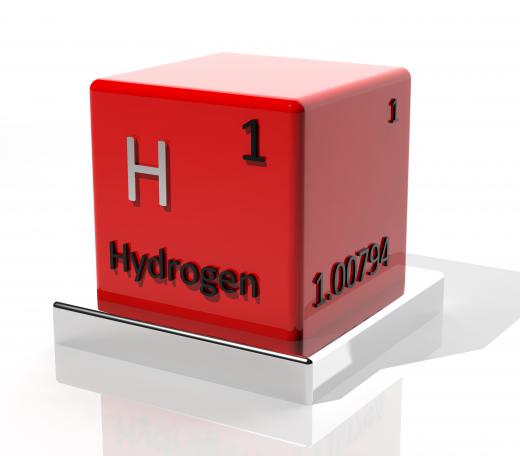What Are the Properties of Hydrogen?
The properties of hydrogen include that, in its natural state on Earth, it is a colorless, odorless gas which is extremely flammable. It is the lightest element known to exist in nature, taking up an average of 75% of all the mass in the universe in stars, planets, and other stellar objects. Hydrogen is also essential for all life on Earth, where it makes up 14% of living matter by weight, as it readily forms bonds with oxygen to create water and carbon to create the molecules that are the base upon which living structures and most organic molecules are built.
While the most abundant form of hydrogen is protium, where it has only one proton in its atomic nucleus and one electron in orbit around the nucleus, two other isotopes of hydrogen exist as well. Protium accounts for 99.985% of all natural hydrogen, and deuterium accounts for another nearly 0.015% having both a proton and neutron in the atomic nucleus, which gives it a mass that is twice that of protium. Tritium is the third form of hydrogen, which is exceedingly rare in nature, but can be produced artificially. It is unstable and exhibits radioactive decay with a half-life of 12.32 years. It has two neutrons in the atomic nucleus for one proton, and is a key compound produced and used in hydrogen bomb weapons to enhance their yield, as well as in nuclear fission energy production, and in nuclear fusion research.

The chemical properties of hydrogen, with just one electron in orbit, lead it to be a highly reactive element that forms bonds with many other elements. In its natural state in the atmosphere, it bonds to another atom of hydrogen as oxygen does, to form H2. H2 molecules can also be unique depending on the spin of their nuclei, with molecules of H2 where both nuclei spin in the same direction being called orthohydrogen, and those with opposing spins known as parahydrogen. Orthohydrogen is the most common form of H2 at normal atmospheric pressure and temperature in gas form, but, when cooled to liquid form such as for rocket fuel, orthohydrogen changes to parahydrogen.

The physical properties of hydrogen and its widespread abundance on land and in the Earth's oceans make it an important area of research as a virtually limitless fuel supply. All forms of fossil-based fuels and alcohols such as gasoline, natural gas, and ethanol are composed of hydrocarbon chains where hydrogen, carbon, and sometimes oxygen are bound together. Separating out pure hydrogen as a clean-burning, abundant fuel source itself is easily done, but the force necessary to break hydrogen free from chemical bonds and then cool it for storage often takes more energy than the pure hydrogen itself can generate. For this reason, the properties of hydrogen mean that its most common uses are where it is found in chemical bonds with other elements.
Research into fusion energy production also relies on the chemical properties of the hydrogen compounds deuterium and tritium. The properties of hydrogen used by all stars fuse atoms of hydrogen together under intense pressure to release helium and energy in the form of light and heat. Similar pressures are being generated in research facilities using powerful magnetic fields, inertial confinement lasers, or electrical pulses in the US, Europe, and Japan.
As the fusing of hydrogen atoms takes place, a helium atom is created that carries 20% of the excess energy from the process, and 80% of the energy is carried by a free neutron. This neutron energy or heat is then absorbed by a fluid to create steam and power a turbine to produce electricity. The process still remains experimental, however, as of 2011. This is due to the tremendous pressures that need to be maintained to fuse hydrogen atoms together continuously and to make machines that can endure temperatures produced in fusion that reach 212,000,000° Fahrenheit (100,000,000° Celsius).
AS FEATURED ON:
AS FEATURED ON:












Discuss this Article
Post your comments